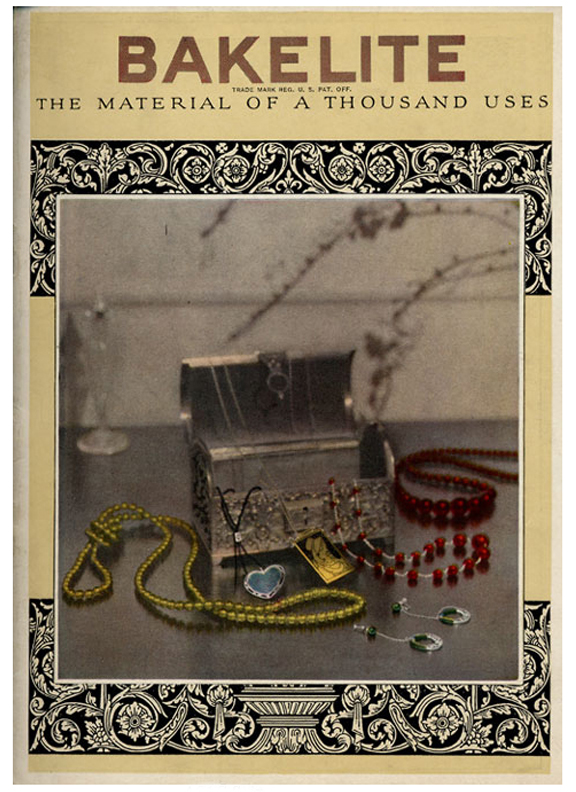

Bakelite: Mystery, History & Facts
By Brad Elfrink
After a few years of carving and selling bakelite jewelry, my curiosity and natural desire for knowledge led me to begin researching and reading information on bakelite, its history and its manufacture. Because there are many conflicting or in-complete opinions and descriptions of the material, I decided to pay closer attention to original information and first hand knowledge from those people I could find who had direct experience with the manufacture and history of bakelite. The search for original information on Bakelite via trade publications and other literature published by the material’s manufacturers led me to find trade publications on file in the Smithsonian Institution, occasionally for sale on ebay and other websites, and in vintage books published by the plastics industry. Fortunately I also found some direct information from people who had been employed by businesses which manufactured or worked with Bakelite. It is from these various sources that I intend to present you with a brief history of Bakelite, an explanation as to why there is so much confusion about what Bakelite truly is and hopefully some understanding of the different forms of Bakelite and the process of its manufacture.

Believe it or not, Dr. Leo H. Baekland invented Bakelite by accident in 1907 while trying to produce a less flammable shellac for bowling alley floors. Dr. Baekland had mixed carbolic acid, also known as phenol, with formaldehyde with an alkalai catalyst and in the presence of heat. The result was a material which he found to be virtually impervious to all manner of solvents, most acids, heat, water, electricity and chemicals. Realizing that this material had many possible applications in the world at the time, Dr. Baekland patented it as Bakelite in 1909 or 1910 along with 399 other patents and organized the General Bakelite Company. Early uses of the new plastic were mainly in the electrical and chemical fields where its high resistance to heat and chemicals provided great insulation and containment possibilities. By 1922 bakelite’s production increased so much that the General Bakelite Company found it necessary to merge with two other companies, the Redmanol Chemical Products Company and The Condensite Company, under a new name “The Bakelite Corporation” in order to keep up with the increased demand for the material. In September of 1924, Time Magazine ran a short article about Bakelite which reads as follows….
“Bakelite.” Superficially, it is a composition, born of fire and mystery, having the rigor and brilliance of glass, the luster of amber from the Isles. Poetically, it is a resin formed from equal parts of phenol and formaldehyde, in the presence of a base, by the application of heat. It will not burn. It will not melt. It is used in pipe stems, fountain pens, billiard balls, telephone fixtures, castanets, radiator caps, etc.. In liquid form, it is a varnish. Jellied, it is a glue. Those familiar with its possibilities claim that in a few years it will be embodied in every mechanical facility of modern civilization. From the time that a man brushes his teeth in the morning with a Bakelite-handled brush, until the moment when he removes his last cigarette from a Bakelite holder, extinguishes it in a Bakelite ashtray, and falls back upon a Bakelite bed, all that he touches, sees, uses, will be made of this material of a thousand purposes. Books and papers will be set up in Bakelite type. People will read Bakeliterature, Bakelitigate their cases, offer Bakeliturgies for their dead, bring young into the world in Bakelitters.”
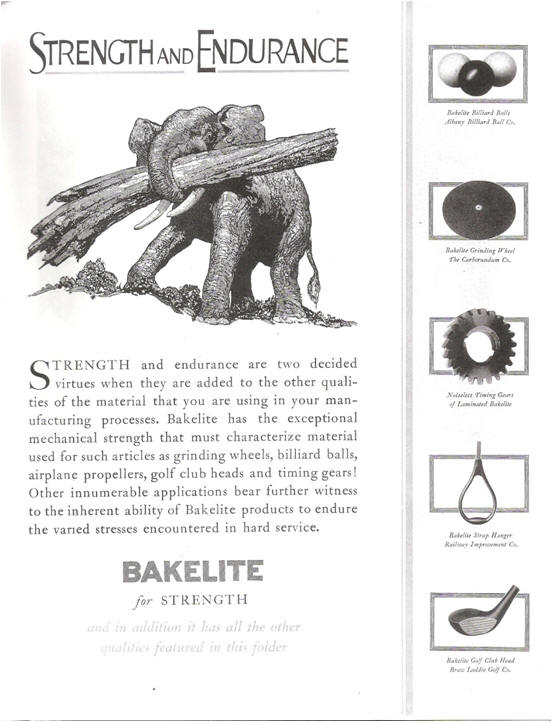
This advertisement from a 1926 Bakelite Corporation publication titled “An Exclusive Combination of Physical, Electrical and Chemical Properties” (courtesy of the Smithsonian Institution) touts Bakelite’s strength and shows it as used to create billiard balls, grinding wheels, timing gears, railway strap hangers, and golf clubs.
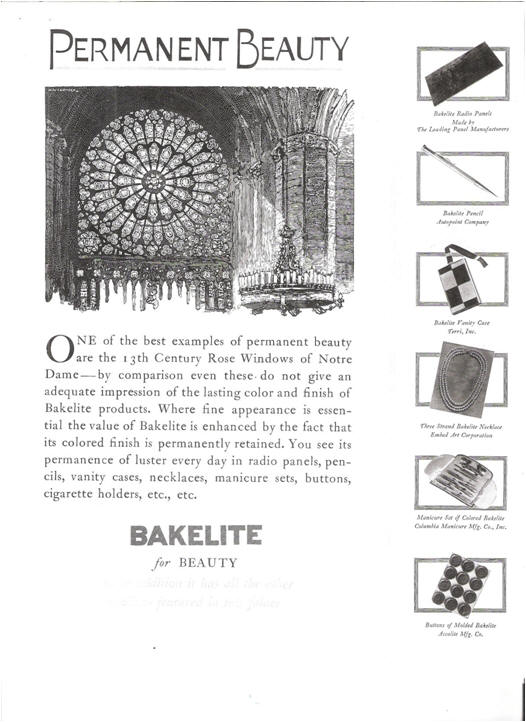
Another ad from the same publication comparing bakelite’s beauty as superior to the 13th century stained glass windows of Notre Dame.
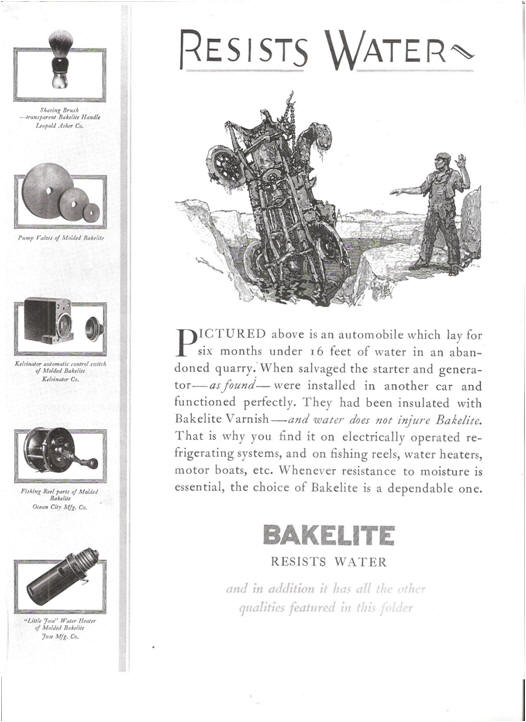
Yet another ad admiring bakelite varnish’s ability to resist water.
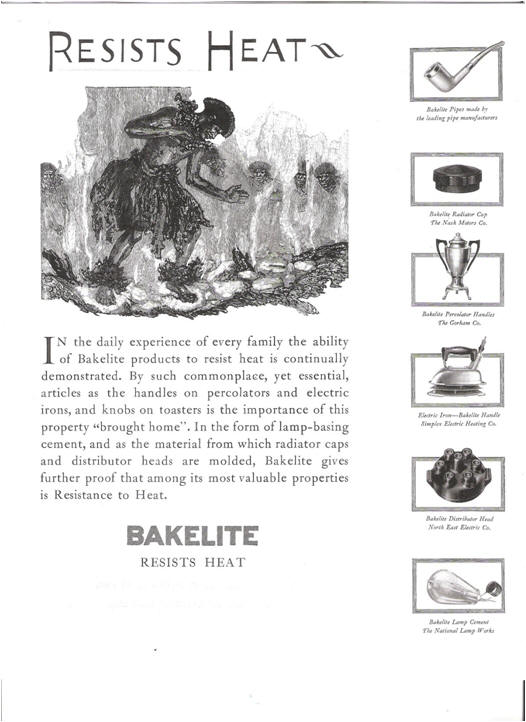
And of course as you can see by this ad showing a native walking barefoot on hot coals…bakelite also resists heat!
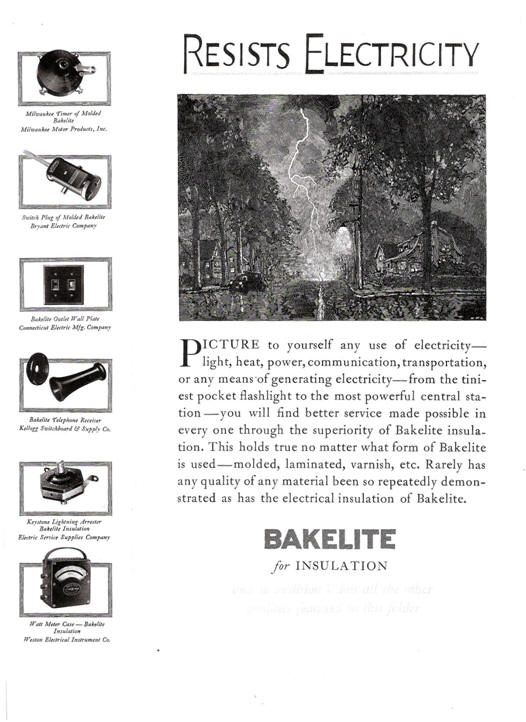
Bakelite resists electricity.
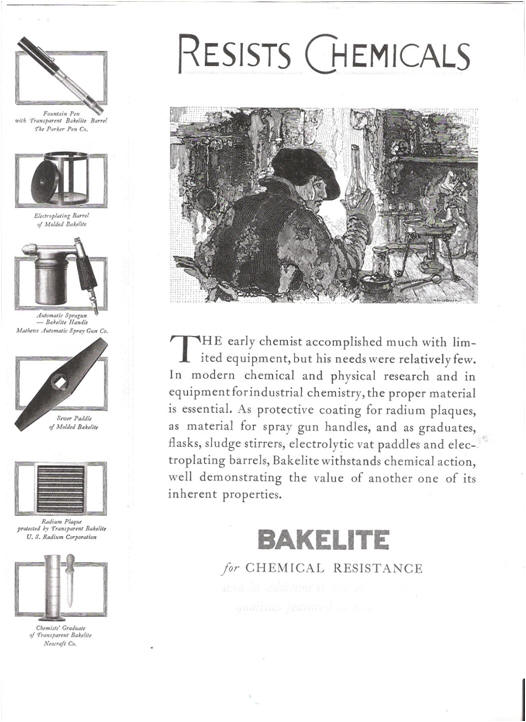
\
…and bakelite resists Chemicals.
As you can see, they had high hopes for this material. Most of the Bakelite produced during this time is more accurately referred to as molded Bakelite. It was mainly utilitarian in use and fairly plain in appearance because it did not take on color easily. It was produced most commonly in the colors black, brown, and red, but also with mottled effects. However, it was not long that it was even produced in bright transparent colors by special order, such as amber, ruby red, green, turquoise and tortoise shell. These colors that had no fillers and were very attractive.
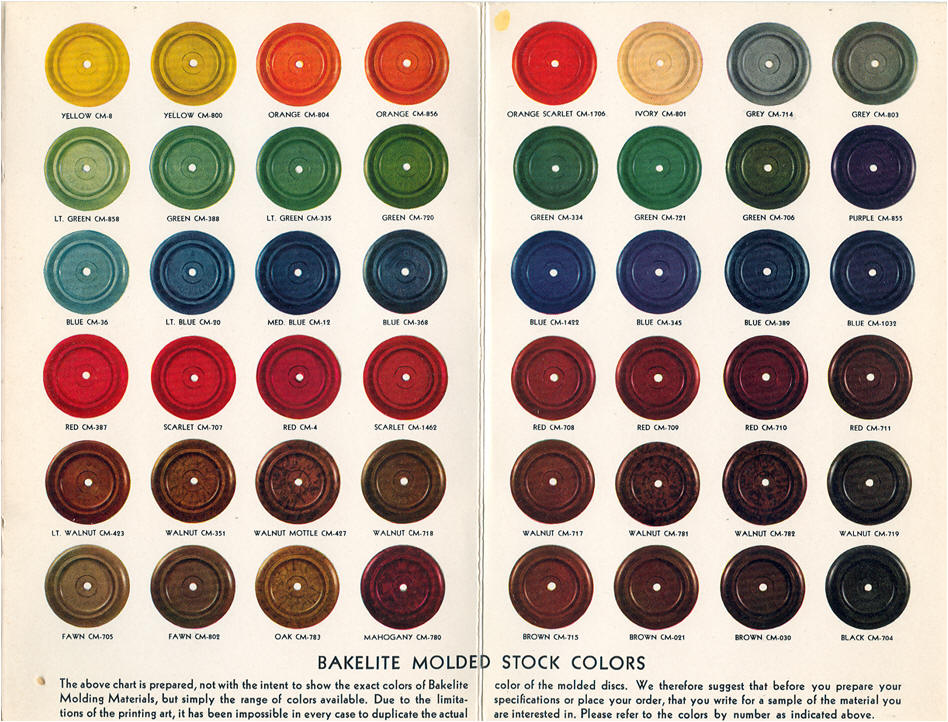
From original 1934 trade literature we find that the production of molded phenolics began in a large sealed reactor vessel which was heated by steam and cooled by cool water. Phenol, formaldehyde, and an alkali catalyst were mixed in the vessel and steam heated. The mixture produced an exothermic reaction which created more heat and this in turn triggered the cooling process. As the mixture cooled, all water and steam were drawn off and a brown syrupy resin formed. This resin was poured into pans and allowed to harden, then crushed into powder and remixed with various fillers. The new mixture was forced into heated steel molds under high pressure. In the presence of the heat and high pressure, the resin again became liquefied and was forced into the cavity of the mold where it hardened into the final form in just a few seconds.
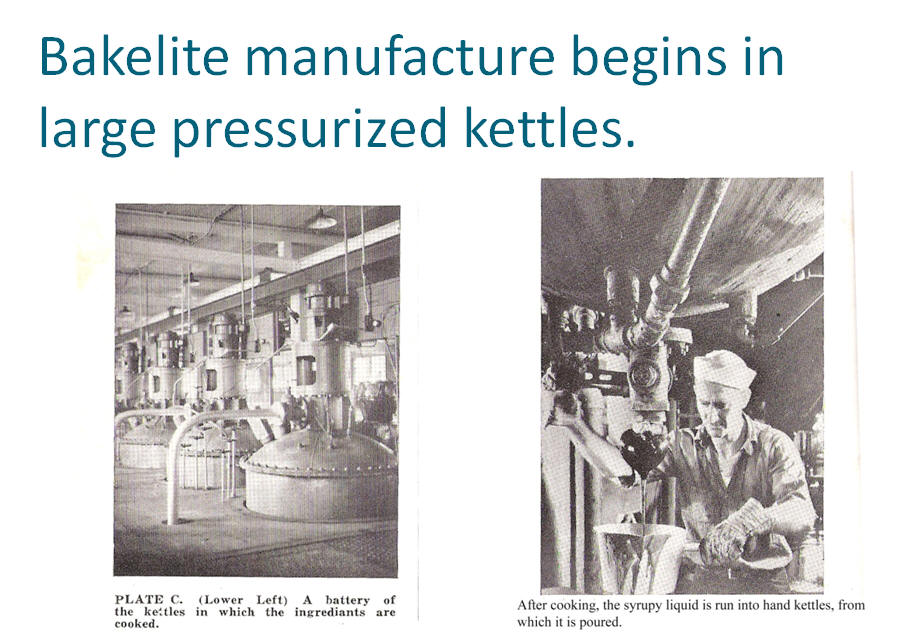
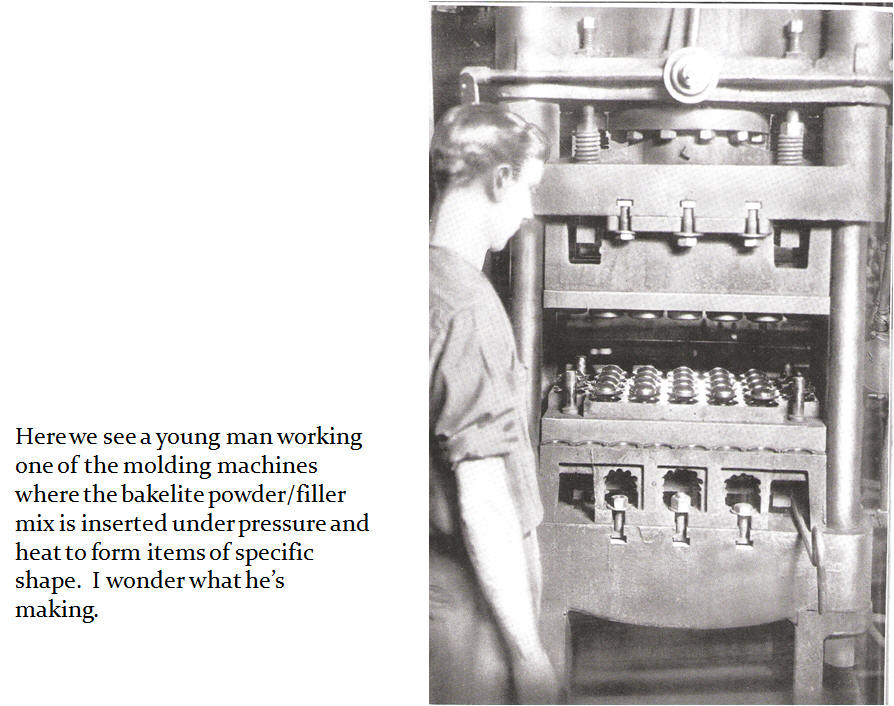
These molded phenolics were made with fillers such as wood flour, asbestos, fabric, cellulose, and paper in order to enhance properties such as better moldability, greater toughness and strength, heat resistance, water and chemical resistance, and shock resistance. Products were available in the stock colors and many companies also purchased special colors to make their products unique.
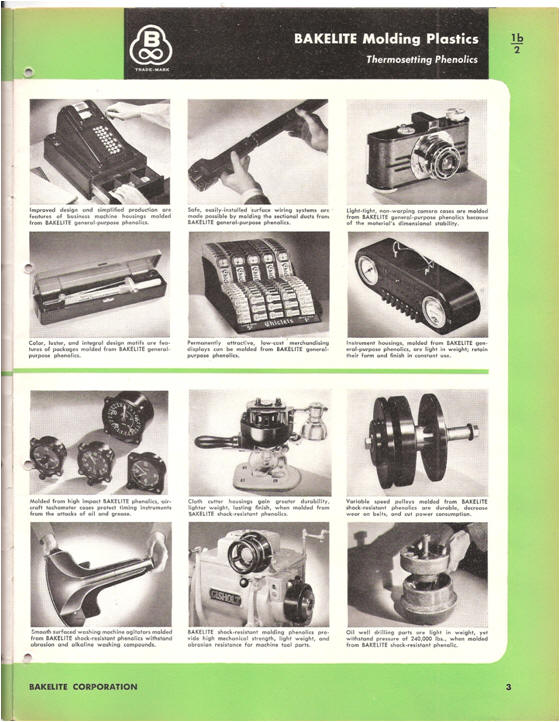
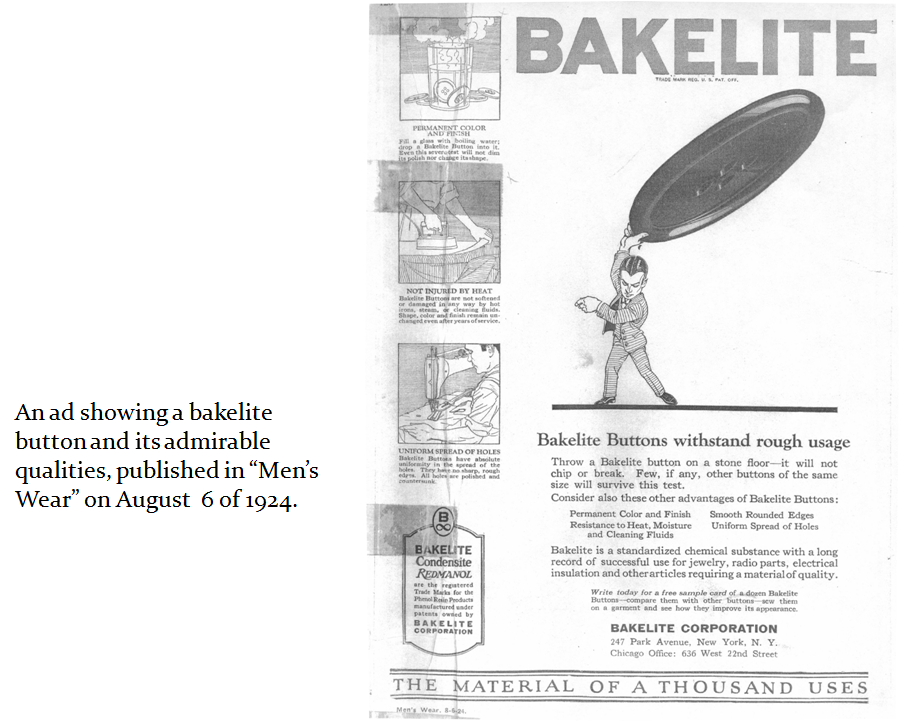
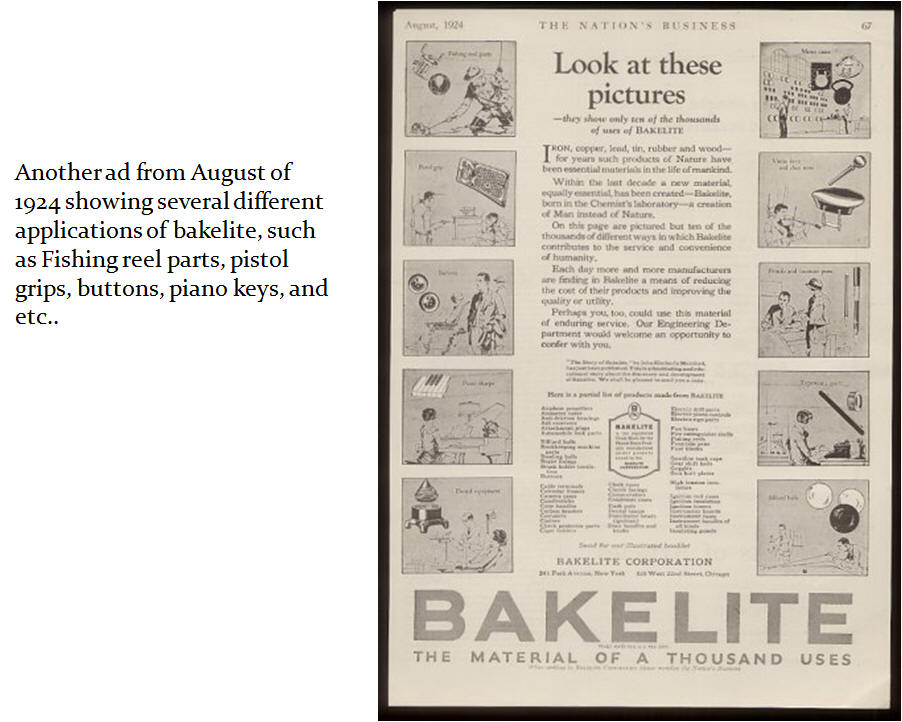
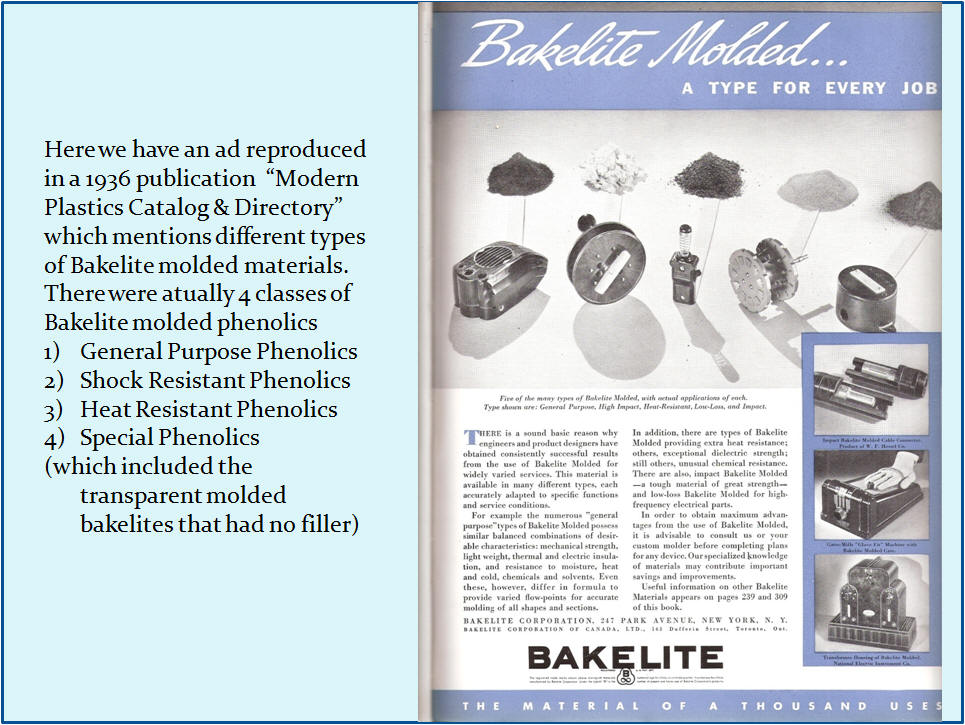
In 1927 the Bakelite patent expired and was acquired by the Catalin Corporation that same year. The Catalin Corporation refined the Bakelite formula and manufacturing process to create cast phenolic resins and renamed the material as Catalin. Dr. Baekeland had actually patented cast phenolics in 1909 with bakelite, and his company produced the cast resins in small amounts until around 1929 when the demand for the molded materials became so high that the company focused on them instead. The Bakelite Corporation was to regret this later because the Catalin Corporation re-introduced this cast phenol-formaldehyde resin in 1928 and by 1933 total sales were 2,800,000 pounds. A few years later in 1941 that number had increased to 6,000,000 pounds. Within a very short time there were many other companies who licensed and used the formula to produce cast phenolic resins and paid Catalin a 4 percent royalty in order to do so.
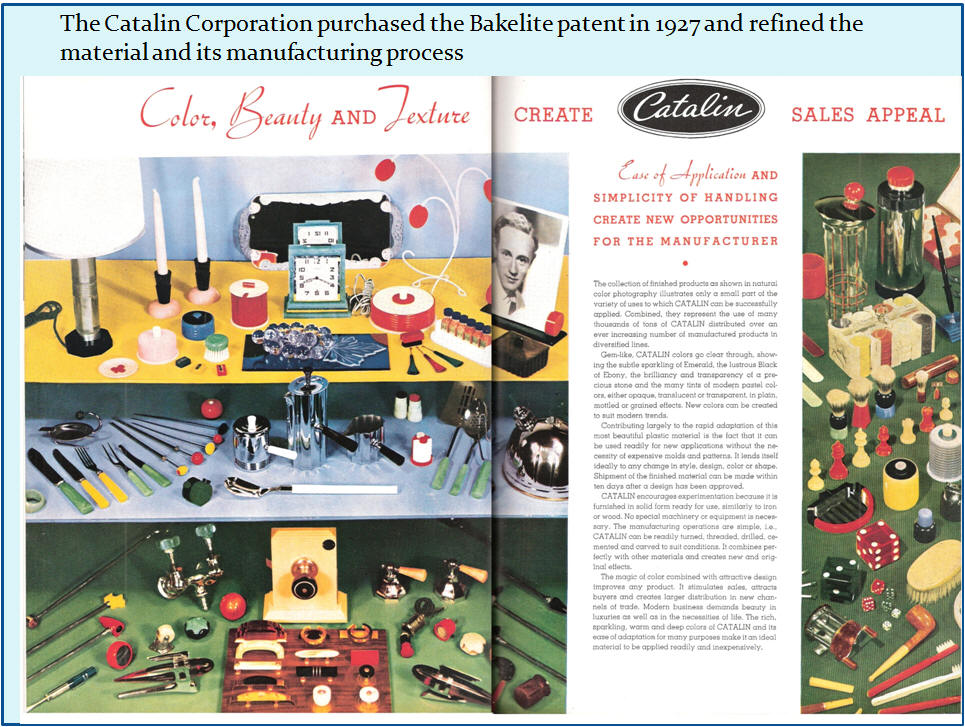
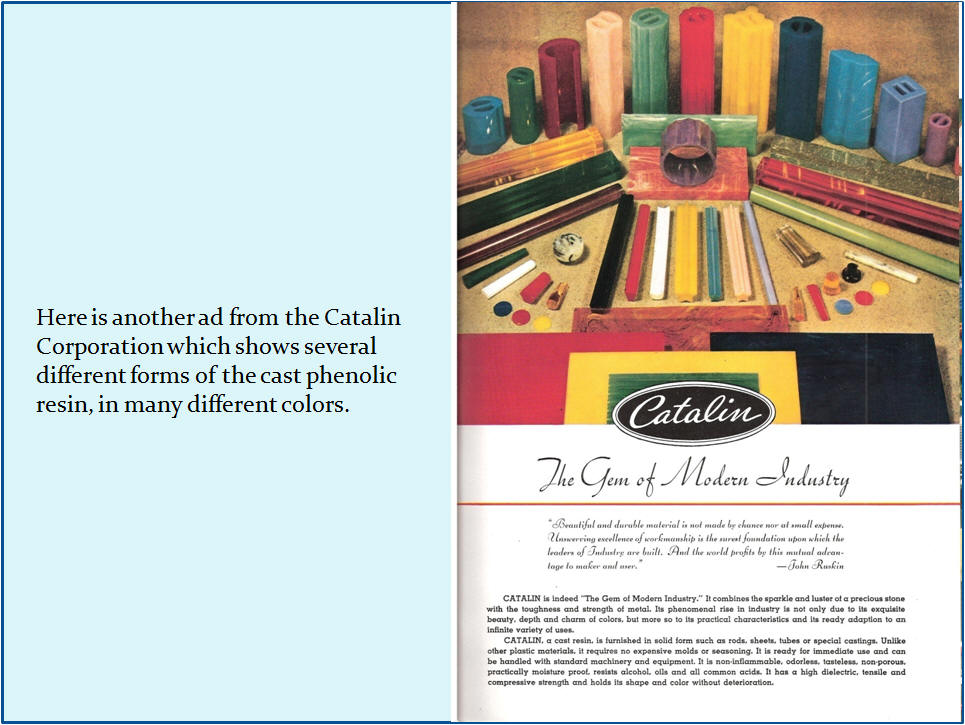
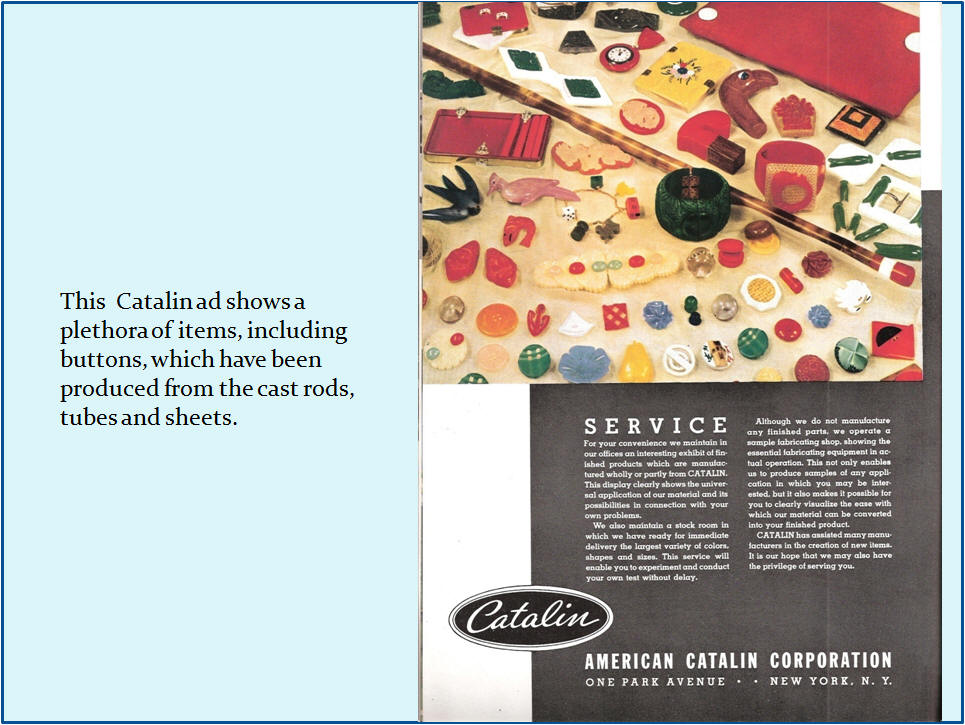
The process for manufacturing cast phenolic resins was only slightly different from that for the molded phenolics. The original mixture of phenol, formaldehyde, and an alkali catalyst were the same, and it was still mixed in similar large capacity pressurized kettles. In the process of manufacturing the original molded phenolics, all water was drawn off from the resin and a strong acid was introduced in order to neutralize the alkali catalyst. With cast phenolics, the water was allowed to remain in the mixture and the alkali catalyst is neutralized by lactic acid. The result is an almost transparent resin which stays liquefied. The water in the mixture performed some of the same purposes as the fillers in molded phenolics by relieving internal stress and lending stability to the cast product. This resin was then dyed and poured into lead molds. If marbled colors were desired, another color such as white was stirred in. The filled lead molds were then wheeled into large kilns or ovens and cured at 200 degrees for a period of 3 to 8 days. Darker colors such as red and blue cured in 3 to 4 days while whites and lighter colors required 6 to 8 days. The fundamental difference between these cast resins and the earlier molded phenolics was thus. The molding powder of the earlier form, reduced to a plastic state in heat and pressure, was shaped into the final product where-as the cast phenolics were hardened into forms as simple shapes or bars and had to be cut and turned into the final product.
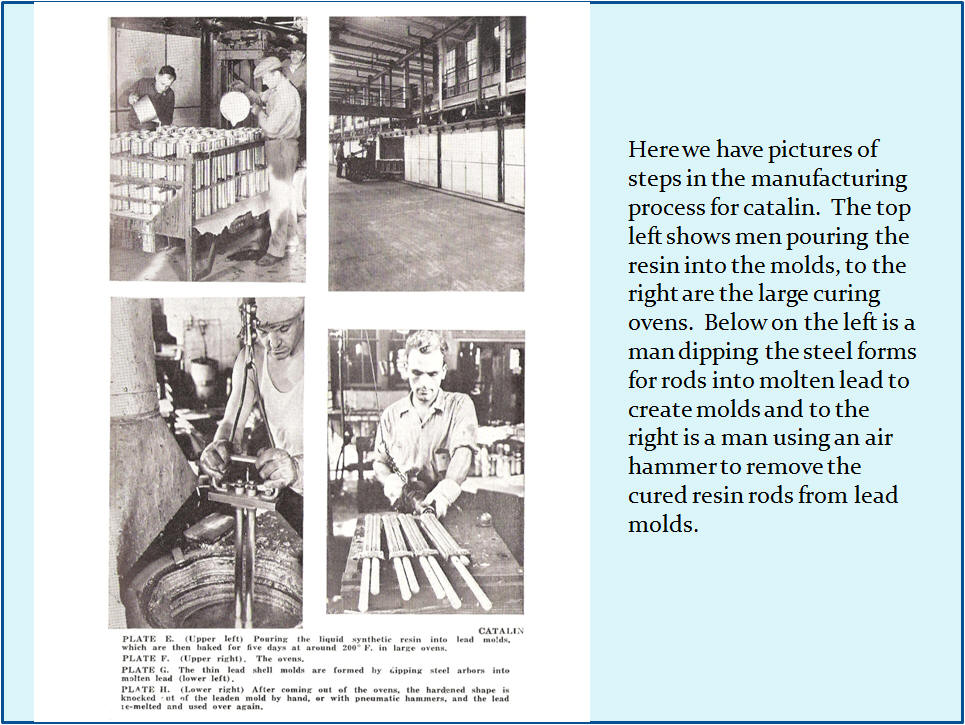
The various shapes which the cast resin were produced in were created by dipping steel arbors into molten lead to create molds. . The steel arbors were grouped into sets of 6 to 30 duplicates and attached together to a handle plate at one end. Once the lead had hardened on the steel arbors, the lead molds were knocked off and filled with resin. Once the resin was cured, it was removed from the lead mold and the lead was melted and reused. Cast resin rods, tubes, sheets and blocks were produced in the thousands this way and shipped all over the world to artisans and companies which in turn machined the material into the products which delight collectors to this day.
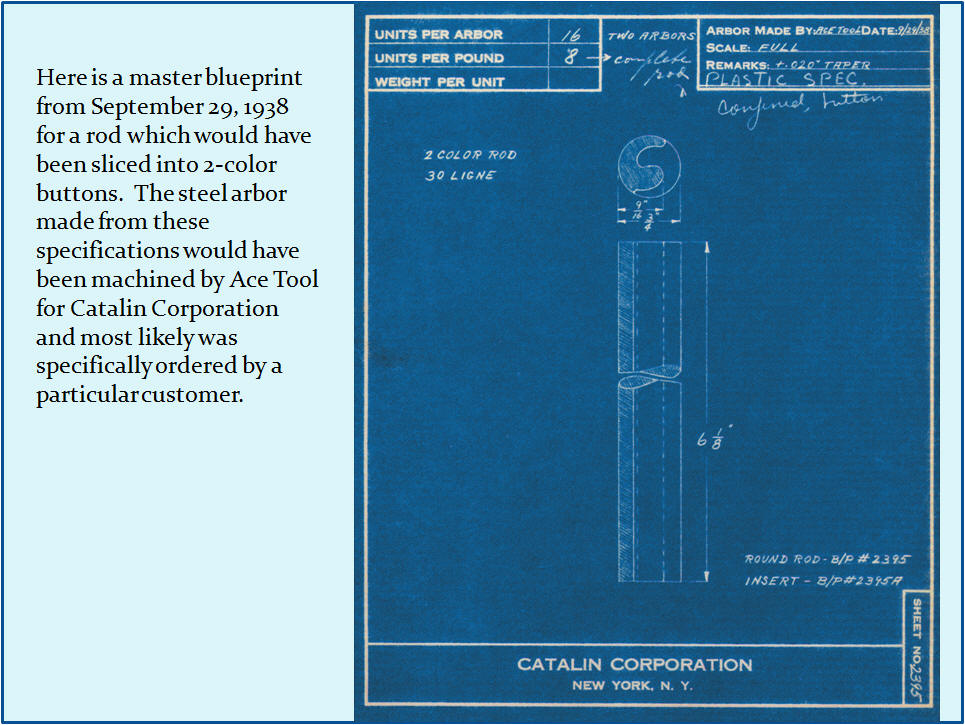
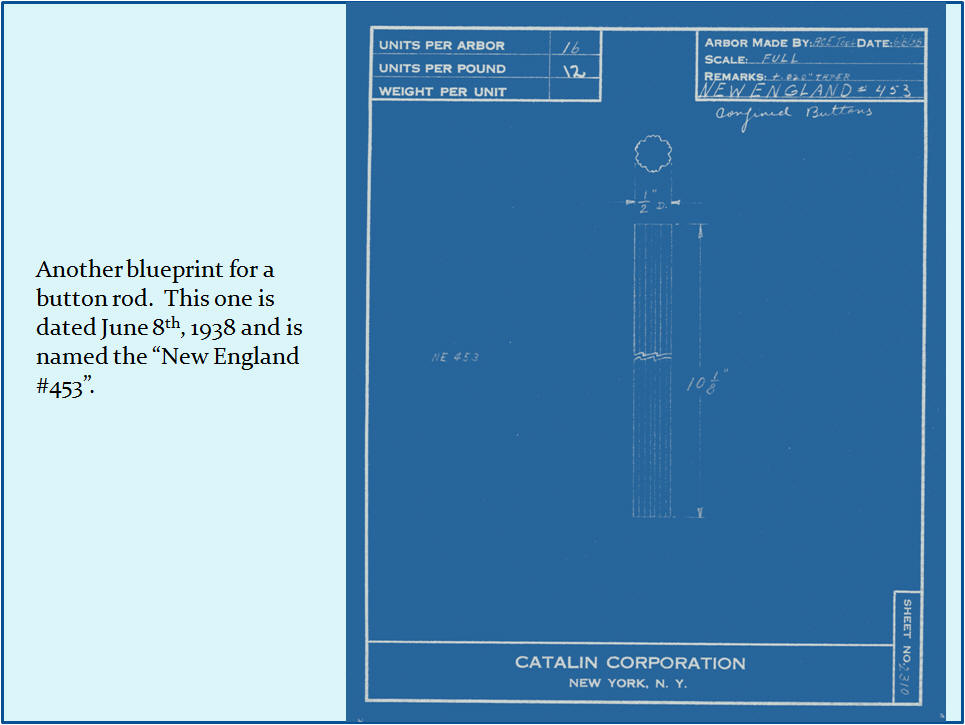
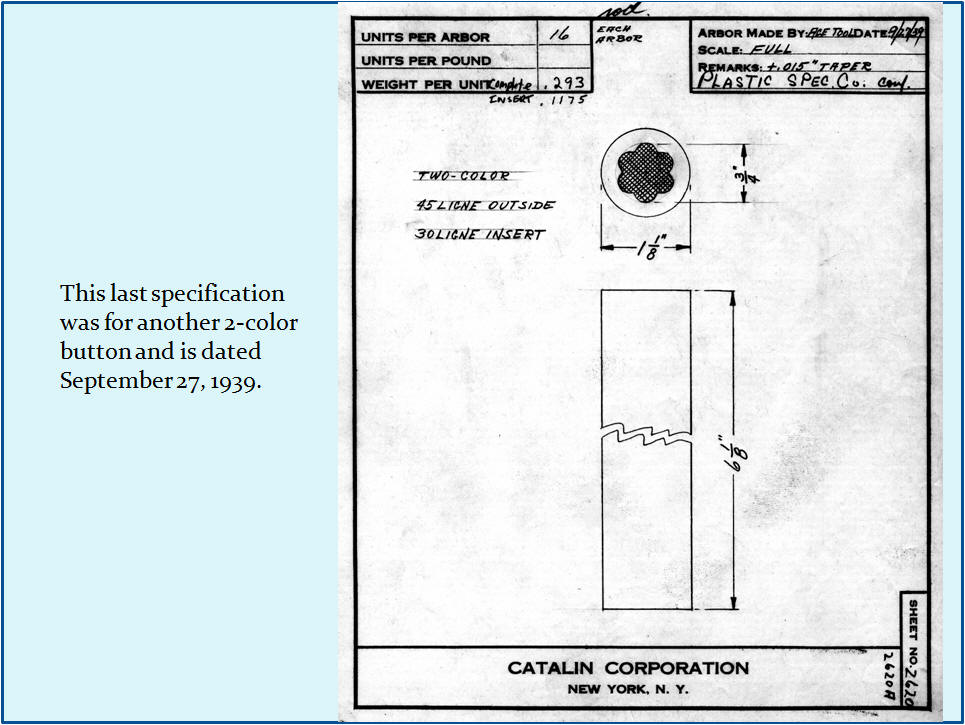
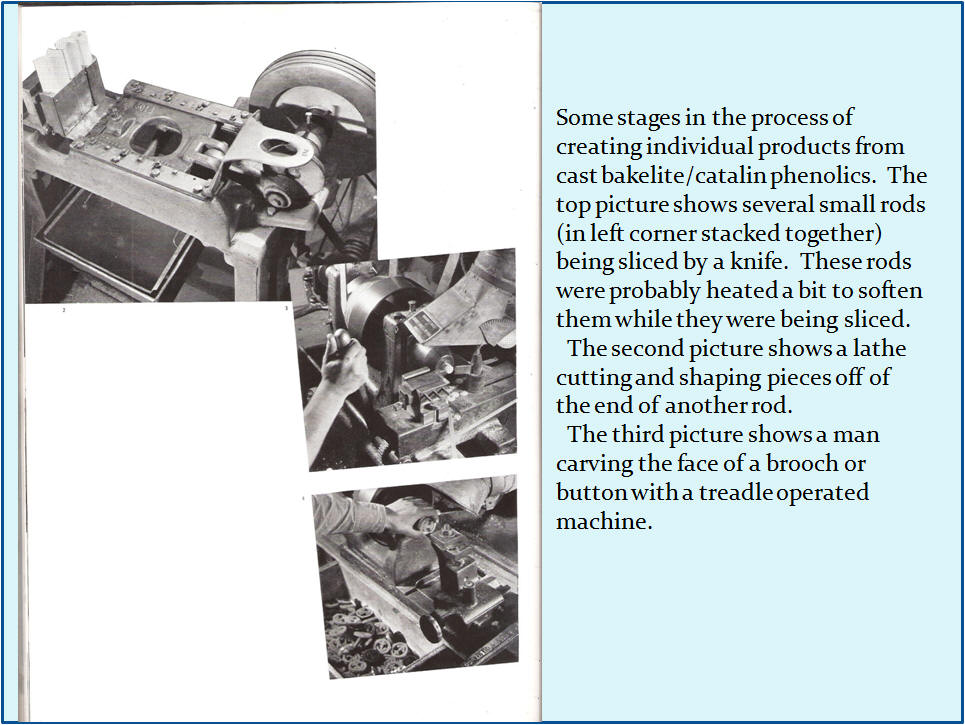
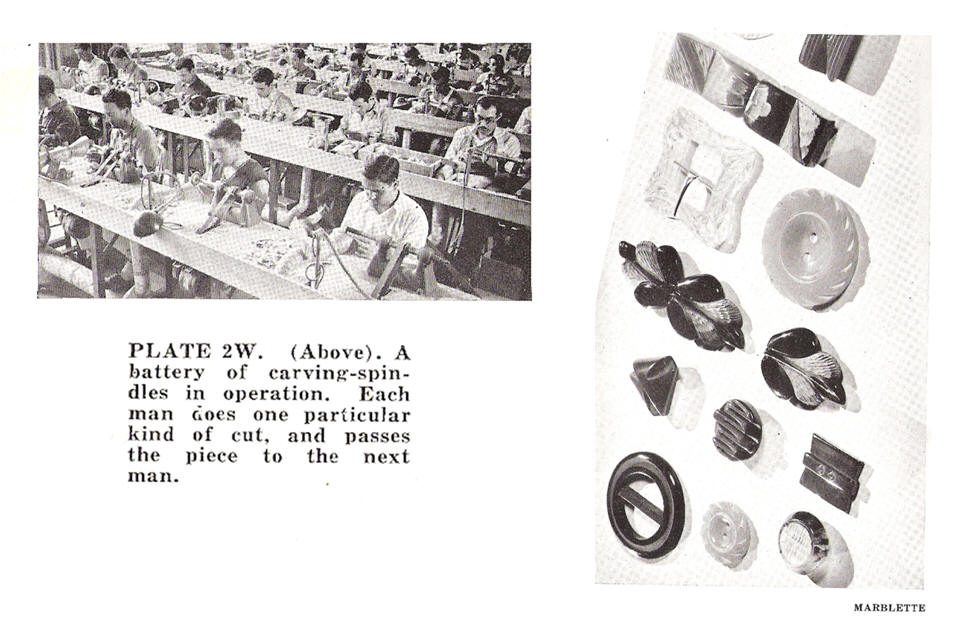
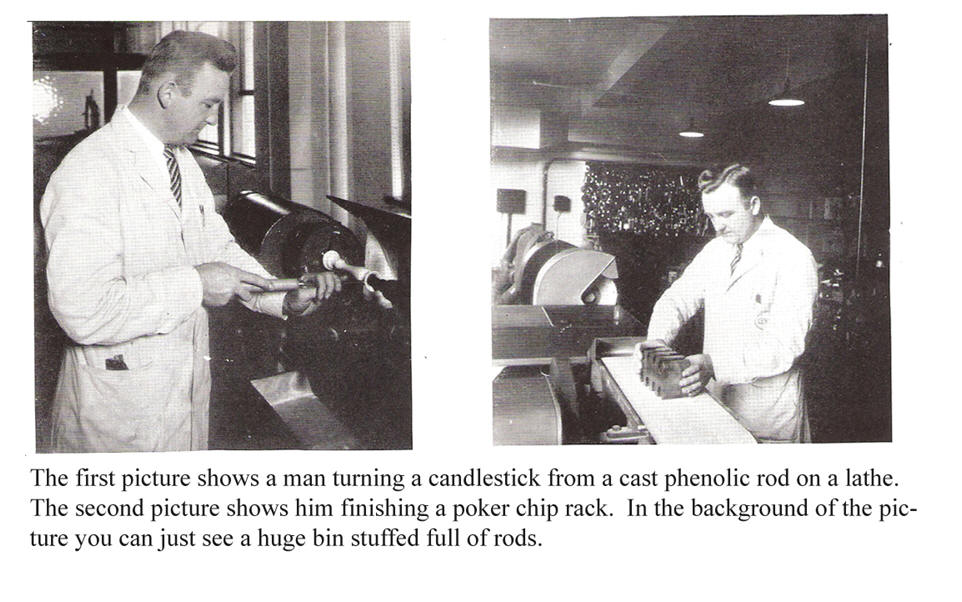
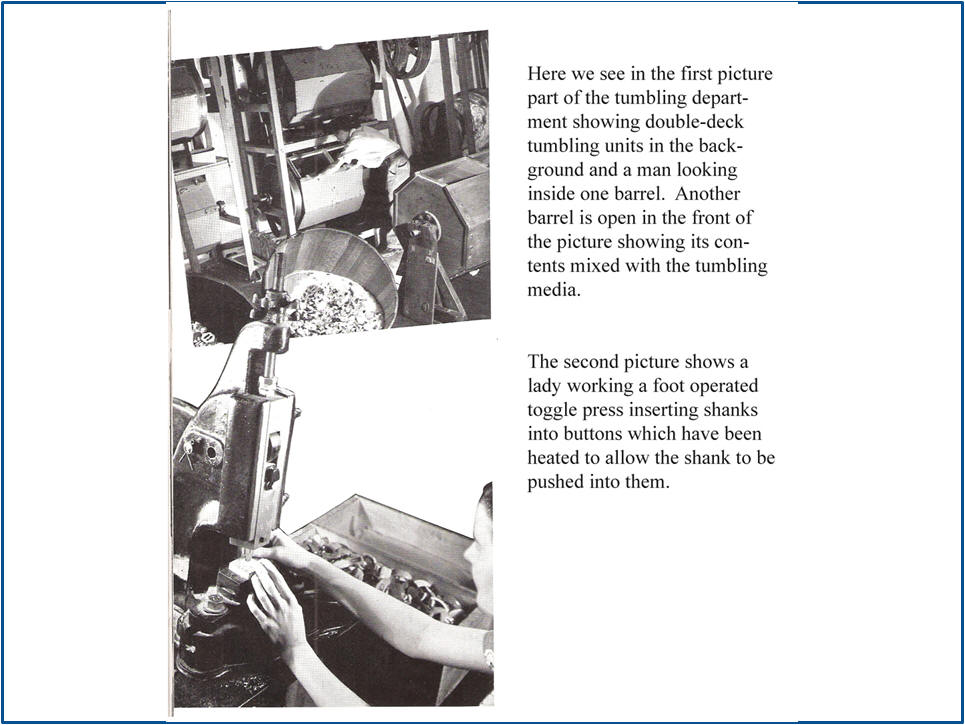
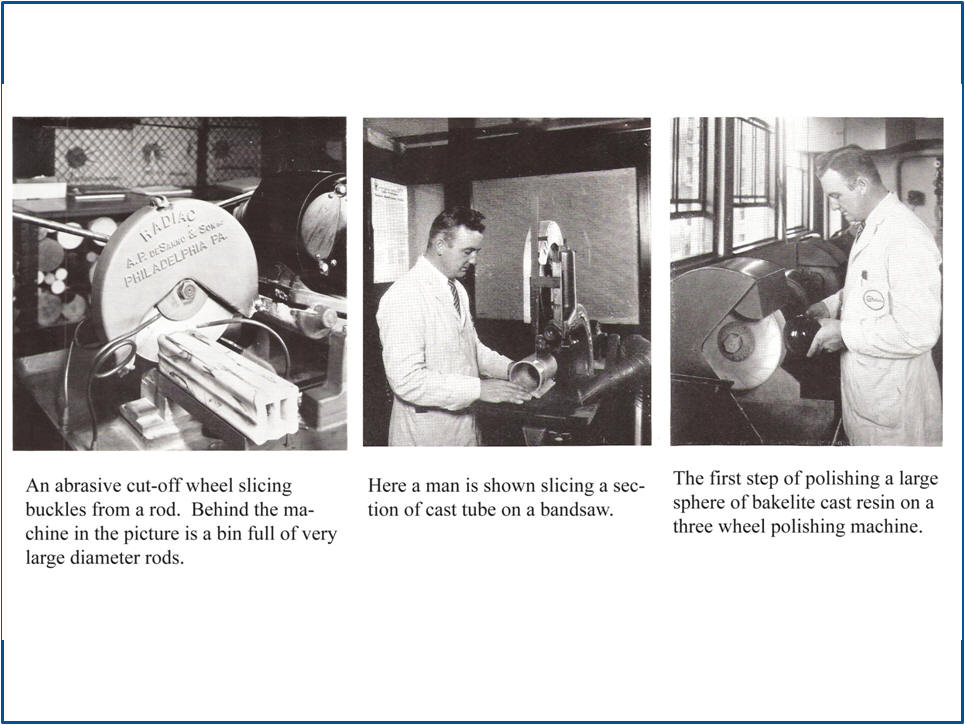
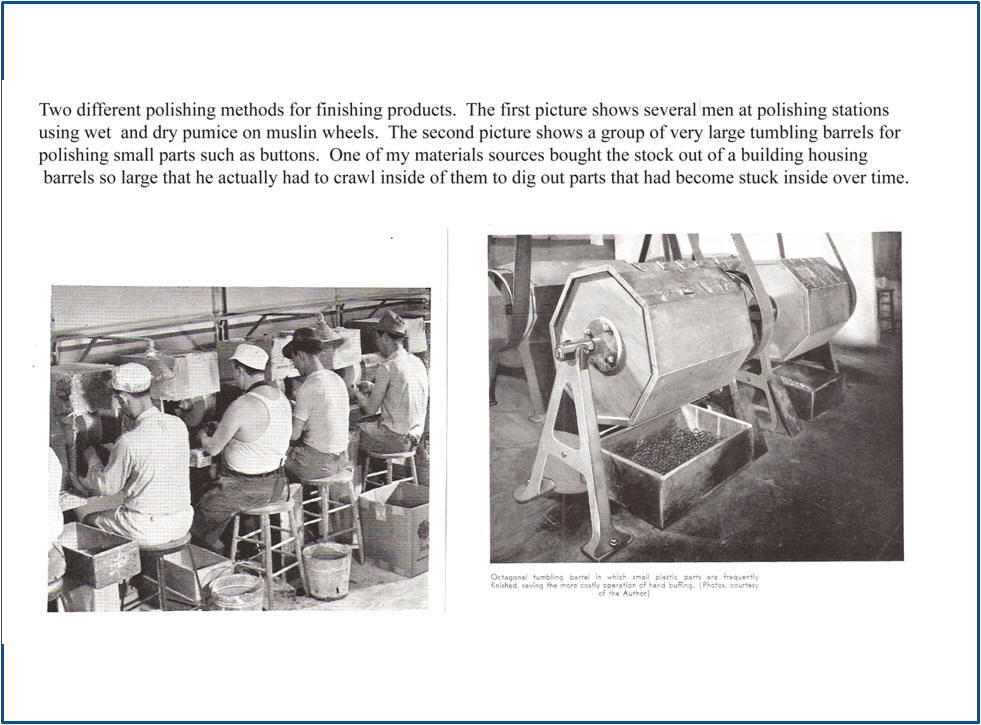
During this time period, cast phenolic resin was produced by several different companies and all of them named the material using their company name first. Bakelite Corporation called their’s “Bakelite Cast Resin”, the Fiberloid Corporation (which was bought out in 1939 by Monsanto) called theirs “Fiberlon”. Catalin Corporation referred to their cast phenolic resin simply as “Catalin” and another company named Marblette called theirs “Marblette”. The Catalin Corporation was responsible for nearly 70% of what is now commonly referred to as Bakelite.
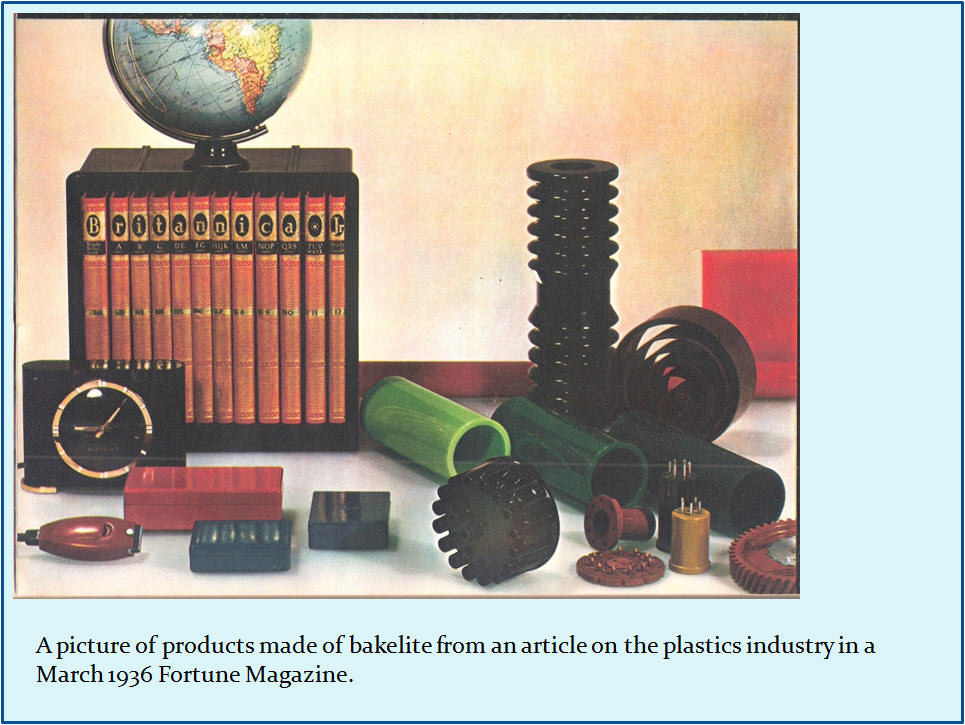
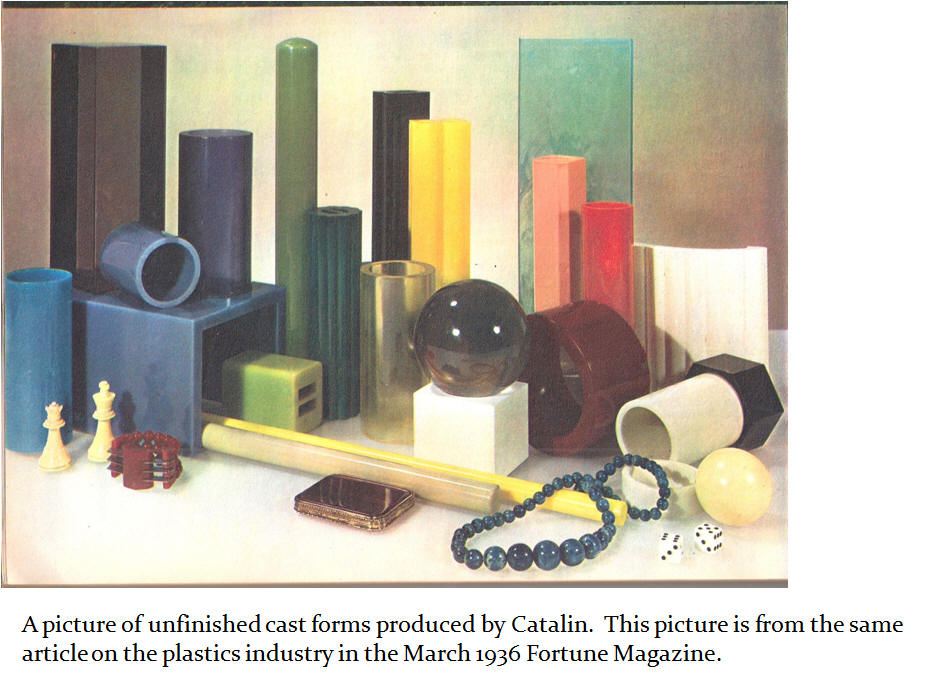
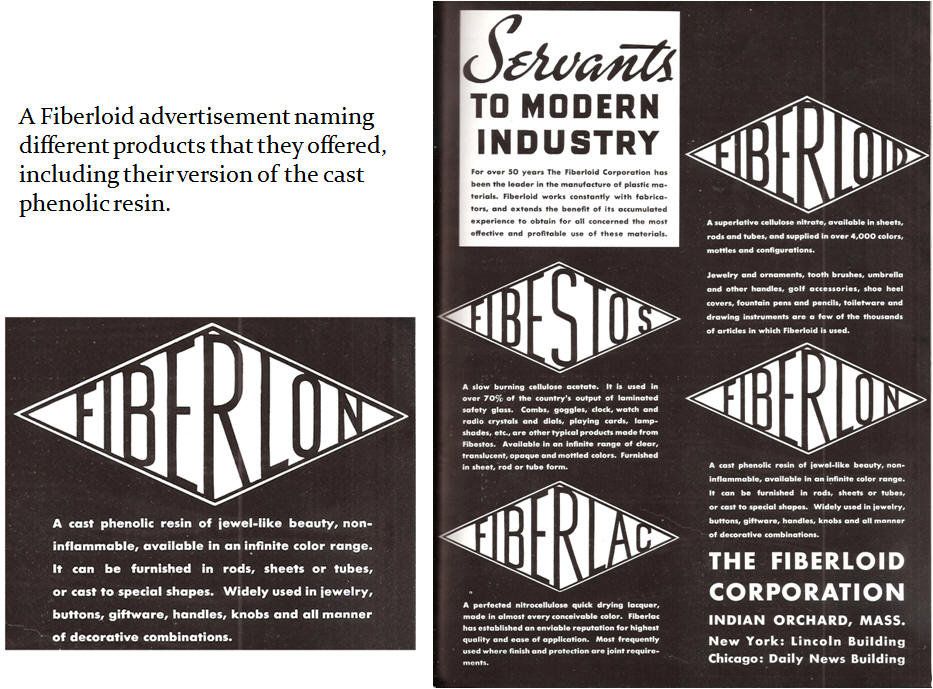
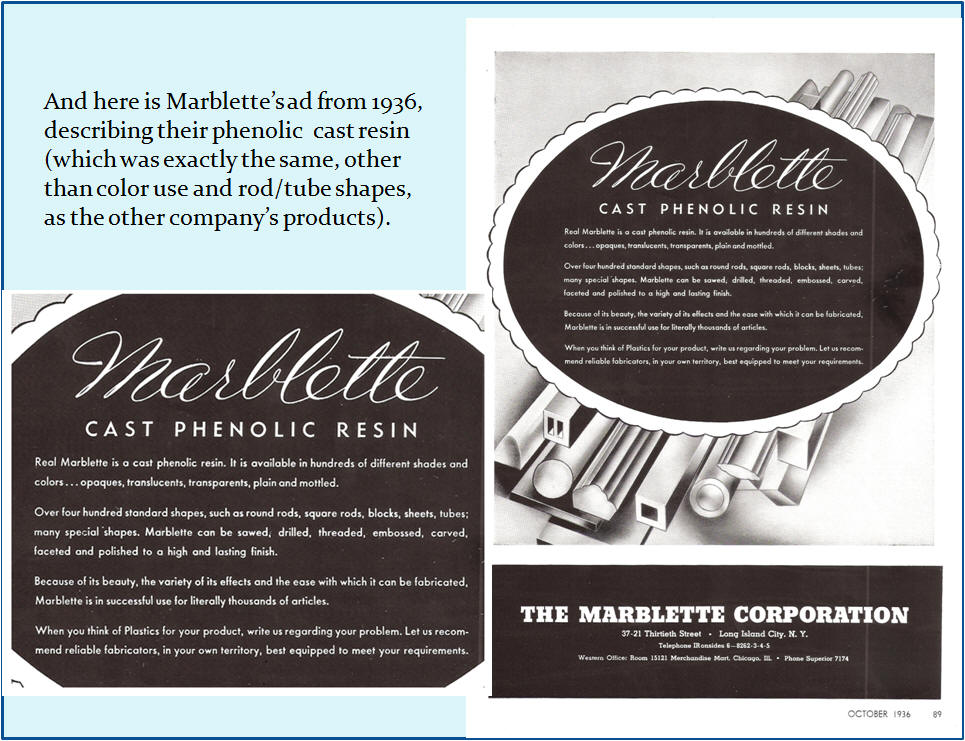
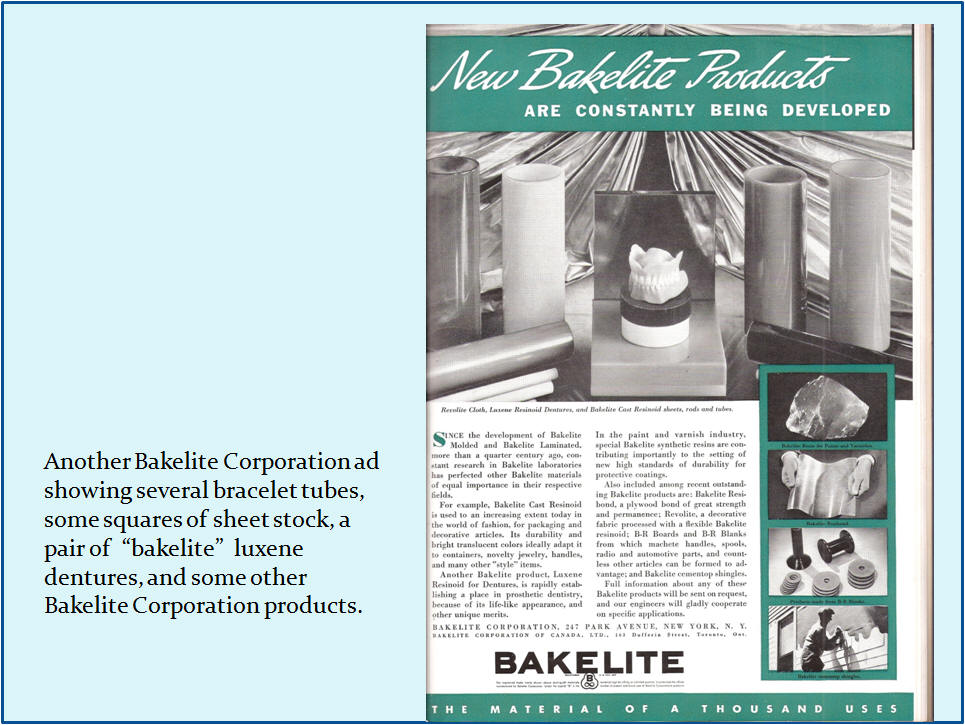
It was this common practice of the companys’ naming processes which is responsible for much of the confusion today with nearly all phenolic resins being referred to as Bakelite, no matter which company produced it and, in the case of Bakelite Corporation products, it didn’t even matter what type of plastic it was. In a 1941 Bakelite Corporation publication titled “New Paths To Profits- A Businessman’s Guide to Modern Plastic Materials” I found the following statements….
“The term “Bakelite” is a trade-mark applied to plastics and other materials produced by Bakelite Corporation. It was derived from the name of Dr. Leo H. Baekland, noted for his discovery, in 1907, of phenol resinoid, and subsequent far-reaching developments in the plastic industry.” “In 1941 the word “Bakelite” was used to identify hundreds of different materials –phenolic, urea, cellulose-acetate, polystyrene, and other plastics developed by the Bakelite Research Laboratories to meet the various needs of industry.”
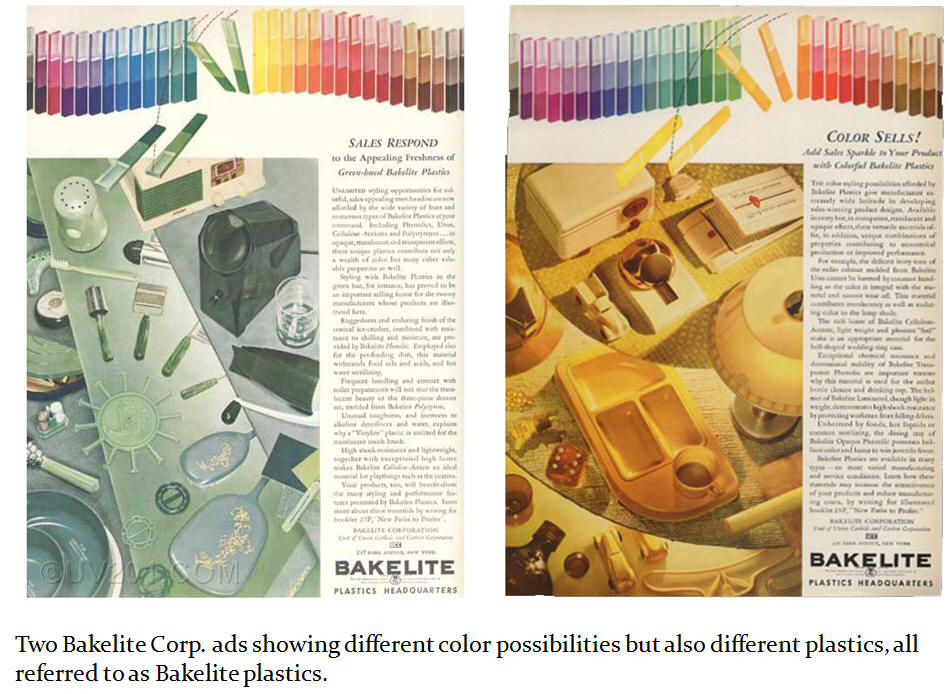
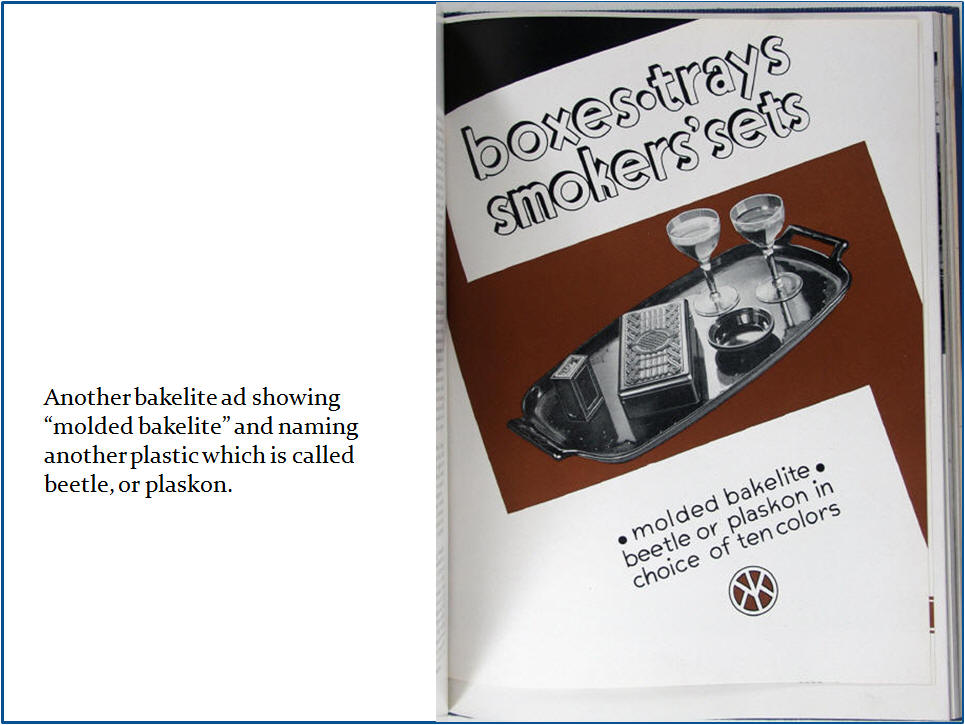
Whatever the name the various companies gave to their phenolic resins, they were all made in exactly the same way and generally had many of the same colors. As time passed, however, more colors and mixtures of colors were used. Many special colors were also developed for individual companies, particularly for the 3 biggest, Bakelite Corporation, Catalin Corporation, and Marblette. According to a 1934 publication, “Bakelite Cast Resinoids, Machining and Finishing” from the Bakelite Corporation, “Bakelite Resinoids were cast in many brilliant and soft colors, opaque, transparent or translucent…mottled, streaked or two-toned. The wide range of colors in which Bakelite cast resinoids are available includes amber, amethyst, blue, ebony, green, ivory, marbled, red and tortoiseshell.” In addition to these I’ve found a list in a book published in 1937 titled “Plastics In the School and Home Workshop” by A. J. Lockrey which names 115 different specific color names that were offered by just one manufacturer and mentions that cast phenolic resins were available in some two or three hundred colors and color combinations. Because it is quite impossible to discern between the phenolic resins produced by the different companies, they have all come to be called Bakelite. Many discerning collectors feel that this term Bakelite as come to be used too loosely, feeling that the only true Bakelite was the original molded materials that were often mixed with fillers and seldom came in bright colors. Other collectors feel that this may be too restrictive and continue to use the term to refer to those molded phenolics as well as the cast phenolic resins which were produced by the Bakelite Corporation. It is my opinion that the two forms should both be referred to with the name “Bakelite” but perhaps with the added distinction of “molded” or “cast”. Molded Bakelite products were virtually finished as soon as they were removed from the molds and include such items as dentures, grinding wheels, pump valves, timing gears, refrigerator breaker strips, door knobs, radio bodies, gear shift knobs, lighting insulation, pot and pan handles, and even a few buttons. Bakelite cast resins were cast in rod, tube, sheet and block form and individual products were cut, carved, sliced, and machined from these. The products include costume jewelry, knobs for doors and automobile gear shifters, cabinet and drawer handles, handles for eating utensils and cutlery, umbrella handles and brushes. The material was used to make radio cabinets, buckles, containers, displays and tons of buttons. Items such as buttons were cast in shaped rods which were then sliced and machined into the finished product, or could be stamped or pressed with the use of heat. Cast phenolic resins will soften just a bit for a very short time at 200 degrees, but the material soon hardens and cannot be softened again.
In 1942 Bakelite and Catalin suspended sales of their colorful phenolic resins in order to concentrate on wartime needs for thousands of related items such as defense phones and aviator goggles. The list of 200 + colors which had been available was pared down to olive green and black. By the end of the war new technology had given the world injection-molded plastics such as acrylic, fiberglass and vinyl, and manufacturers switched to the cheaper and less labor intensive products. Although bakelite production was nearing its end there was still some demand for the brightly colored plastic in form of jewelry, buttons and other such cosmetic items. Marblette Corporation bought out Catalin Corporations cast phenolic business around 1956 and continued production in limited amounts for another several years. Catalin Corporation remained in business but no longer produced cast phenolics. The materials involved in the manufacture of the material, and the labor involved, had become too expensive. Today phenolic resins are only produced for their insulating properties and mainly in the electrical and chemical fields. One company in Belgium still produces billiard balls from the material and now calls it Aramith. Many Asian countries have experimented with various resins and added formaldehyde to the mixtures in order to reproduce items to fool collectors, and in many cases have been quite successful, but true bakelite molded and cast phenolics are no longer being produced as far as I know. The last reference I’ve heard of relating to bakelite cast resins being produced was from sometime in the early 1970’s but I have not been able to find recorded information relating to that era.
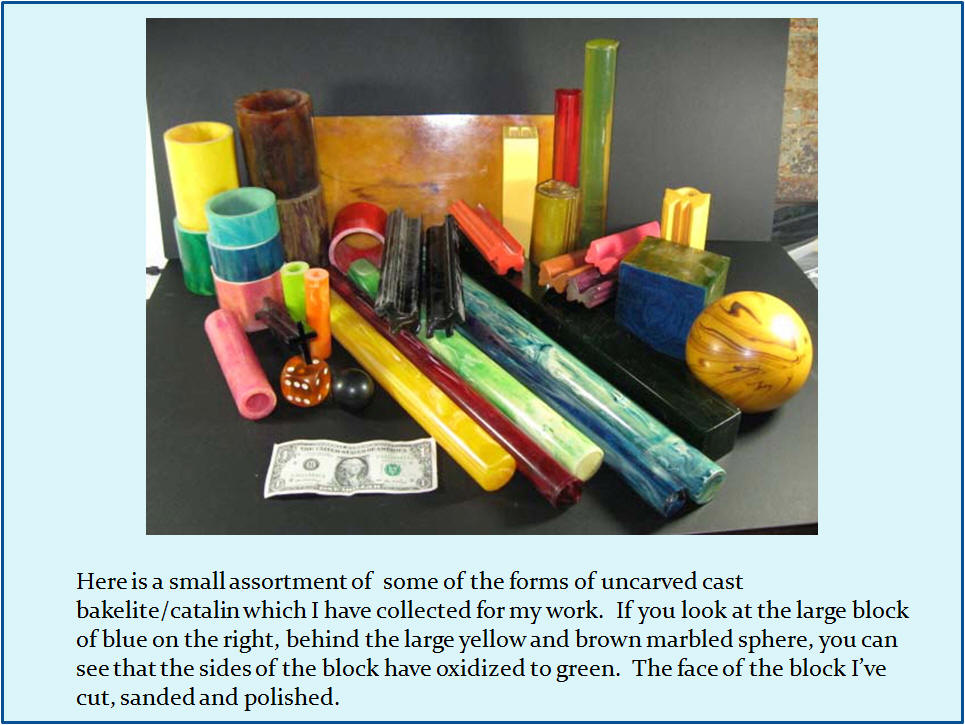
Over the past several years I have amassed quite a diverse collection of cast phenolic Bakelite forms from different parts of the country, in a wide array of colors. Because of the sheer numbers of the unfinished product which were produced and sold, from time to time the raw uncarved materials come up for sale and sell for up to several hundred dollars per piece depending on the form, size and color. And I've found that the colors are as varied as are the shapes. Over time, as many collectors have noticed, bakelite oxidizes and turns from its original color to another. This effect can cause the bakelite to change color from a bright hue to one which is darker and more drab, or just as often it can turn a marbled color into an even more dramatic mixture of swirling colors. This color change is due to the affects of ultraviolet light which turns the phenolic resin into phenyl alcohol. Phenyl alcohol is yellow-brown in color and it is this residue which many collectors test for using simi-chrome polish and a cotton swab. The phenyl alcohol actually serves to block ultraviolet light from penetrating past the surface of the bakelite item and, once the surface is sanded and polished, the item can be returned to its original bright colors.